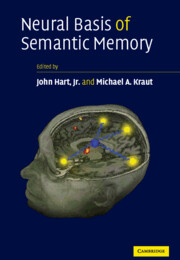Book contents
- Frontmatter
- Contents
- List of contributors
- Preface
- Part I Semantic Memory: Building Models from Lesions
- Part II Insights from Electrophysiology
- Part III Applications of Models to Understanding Cognitive Dysfunction
- Part IV Representations of Nouns and Verbs vs. Objects and Actions
- 6 Effects of word imageability on semantic access: neuroimaging studies
- 7 The neural systems processing tool and action semantics
- 8 The semantic representation of nouns and verbs
- Part V Critical Role of Subcortical Nuclei in Semantic Functions
- Part VI Conceptual Models of Semantics
- Index
- References
8 - The semantic representation of nouns and verbs
from Part IV - Representations of Nouns and Verbs vs. Objects and Actions
Published online by Cambridge University Press: 14 September 2009
- Frontmatter
- Contents
- List of contributors
- Preface
- Part I Semantic Memory: Building Models from Lesions
- Part II Insights from Electrophysiology
- Part III Applications of Models to Understanding Cognitive Dysfunction
- Part IV Representations of Nouns and Verbs vs. Objects and Actions
- 6 Effects of word imageability on semantic access: neuroimaging studies
- 7 The neural systems processing tool and action semantics
- 8 The semantic representation of nouns and verbs
- Part V Critical Role of Subcortical Nuclei in Semantic Functions
- Part VI Conceptual Models of Semantics
- Index
- References
Summary
That which we call a rose
By any other name would smell as sweet.
William Shakespeare, Romeo and Juliet, Act II, Scene 2Introduction
What's in a name? For cognitive science, the question is more than rhetorical. Rather, it gets to the heart of what we know – and do not know – about how words are stored and retrieved by the human brain, and there are several competing ideas about how it should be approached. The question becomes even more complex when one considers that not all words are names, or nouns; a complete theory of lexical semantics should also account for the meaning of verbs, adjectives, and other so-called “content” words, associated with what many have argued are fundamentally different types of concepts (O'Grady, 1997). Where can we begin?
Sensory/functional approaches
One school of thought holds that there are roughly two kinds of semantic knowledge associated with the lexical entry for any given word. On the one hand, there is information that derives directly from the senses, including features representing an object's smell, color, size, and propensity to have sharp thorns. On the other hand, there is everything else – for example, the same item's monetary and sentimental value, where it can typically be found, and whether it is suitable for consumption as jam. The latter sort of information is often (somewhat imprecisely) called “associative” or “functional.” Accordingly, this method of partitioning the lexicon has been called the sensory/functional theory (SFT) of semantic knowledge.
Keywords
Information
- Type
- Chapter
- Information
- Neural Basis of Semantic Memory , pp. 205 - 216Publisher: Cambridge University PressPrint publication year: 2007
